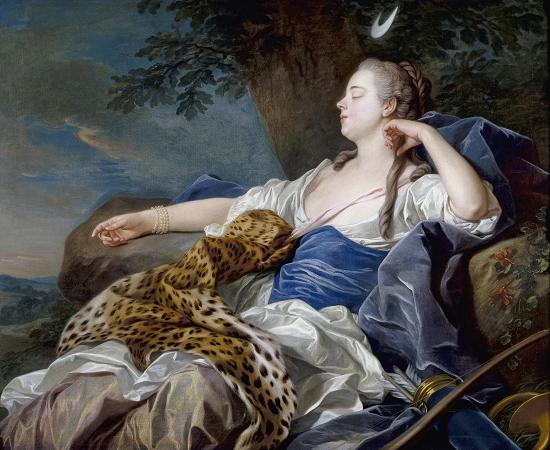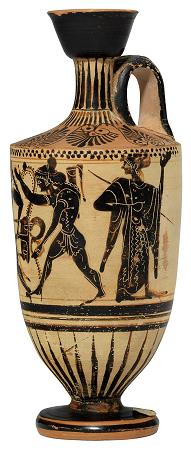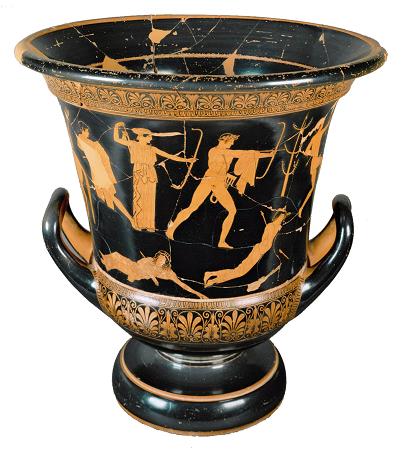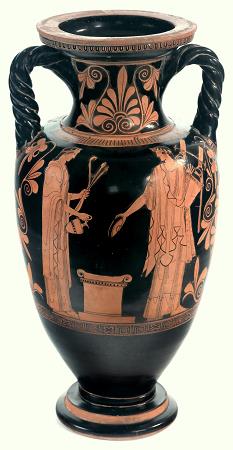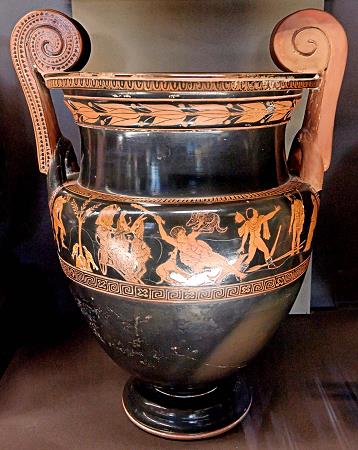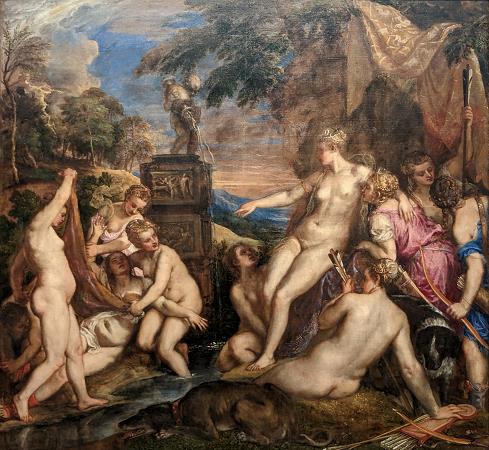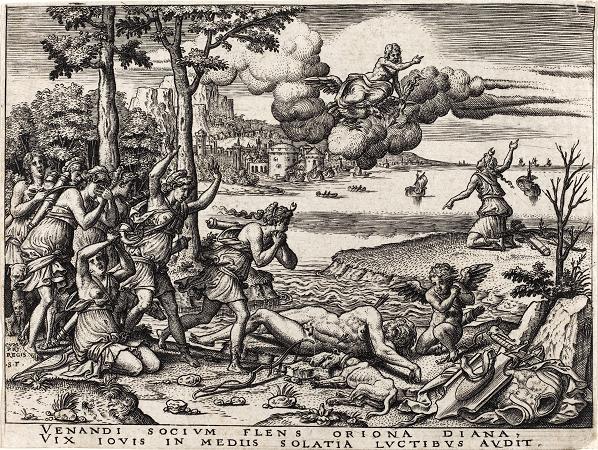Diana / Artemis. Diana, the Roman goddess of the hunt, the moon, and chastity, is the counterpart of the Greek goddess Artemis. In art, Diana is often depicted as a beautiful, strong, and independent woman who embodies the ideals of virginity and the power of nature. She is frequently depicted with hunting gear, such as a bow and arrow, a quiver, or a hunting dog. She may be shown in the act of hunting or accompanied by other hunters, emphasizing her role as the goddess of the hunt. As the goddess of the moon, Diana is often associated with the crescent moon symbol. In art, she may be shown with a crescent moon on her forehead, in her hair, or held in her hand. She is often depicted in woodlands, forests, or other wild, untamed environments that reflect her connection to nature and her role as a protector of wild animals. Also, she is frequently portrayed in the company of nymphs, who are her devoted followers and companions. These nymphs may be shown bathing, resting, or engaging in other leisure activities with the goddess. One popular episode from the myth of Diana involves the hunter Actaeon, who accidentally stumbles upon the goddess bathing with her nymphs. In art, this scene may be depicted as a dramatic moment of discovery, with Diana and her nymphs reacting in surprise and outrage. The story ultimately ends with Actaeon being transformed into a stag and torn apart by his own hunting dogs. Another well-known myth associated with Diana is the story of Callisto, a nymph who is transformed into a bear after being seduced by the god Jupiter. In art, this scene may be depicted as a moment of tension and transformation, with Diana and her nymphs encountering the bear, who was once their companion. She was one of the three maiden goddesses, along with Minerva and Vesta, who swore never to marry. Oak groves and deer were especially sacred to her. Diana made up a triad with two other Roman deities; Egeria the water nymph, her servant and assistant midwife; and Virbius, the woodland god. Diana is revered in modern Neopagan religions including Roman Neopaganism, Stregheria, and Wicca. From the medieval to the modern period, as folklore attached to her developed and was eventually adapted into neopagan religions, the mythology surrounding Diana grew to include a consort and daughter, figures sometimes recognized by modern traditions. In the ancient, medieval, and modern periods, Diana has been considered a triple deity, merged with a goddess of the moon and the underworld. On the tablets of Pylos a theonym di-wi-ja is supposed as referring to a deity precursor of Artemis. Modern scholars mostly accept the identification. people regard Diana and the moon as one and the same. the moon is so called from the verb to shine. Lucina is identified with it, which is why in our country they invoke Juno Lucina in childbirth, just as the Greeks call on Diana the Light-bearer. Diana also has the name Omnivaga, not because of her hunting but because she is numbered as one of the seven planets; her name Diana derives from the fact that she turns darkness into daylight. She is invoked at childbirth because children are born occasionally after seven, or usually after nine, lunar revolutions.--Quintus Lucilius Balbus as recorded by Marcus Tullius Cicero and translated by P.G. Walsh. De Natura Deorum, Book II, Part ii, Section c The persona of Diana is complex, and contains a number of archaic features. Diana was originally considered to be a goddess of the wilderness and of the hunt, a central sport in both Roman and Greek culture. Early Roman inscriptions to Diana celebrated her primarily as a huntress and patron of hunters. Later, in the Hellenistic period, Diana came to be equally or more revered as a goddess not of the wild woodland but of the tame countryside, or villa rustica, the idealization of which was common in Greek thought and poetry. This dual role as goddess of both civilization and the wild, and therefore the civilized countryside, first applied to the Greek goddess Artemis.
more...
